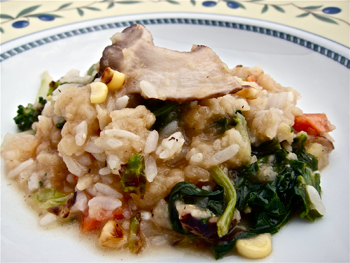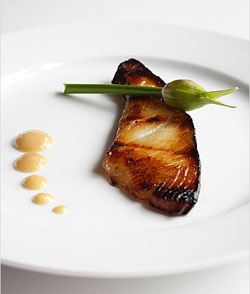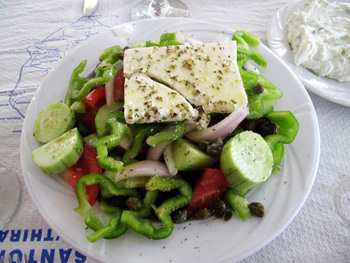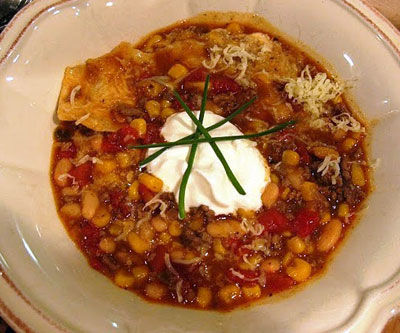 Congee is rice served "wet" in a broth with vegetables, tofu, meat, seafood, or poultry.
Congee is rice served "wet" in a broth with vegetables, tofu, meat, seafood, or poultry.
Congee is the Asian equivalent of Jewish chicken soup, perfect when the weather is cold and damp or you're fighting off a cold. Served in a variety of ways, depending on the country of origin or what's in season, the basic dish is made with cooked rice, a liquid, and flavorings. You'll find dozens of authentic, regional recipes in cookbooks and online, but in our kitchen "congee" is another way of saying repurposed deliciousness.
Whatever we don't eat at a Japanese, Chinese, Vietnamese, or Thai restaurant we bring home. Invariably, a container of rice is included along with the kung pao chicken, tempera shrimp and vegetables, stir fried beef with broccoli, or sweet and sour pork that we couldn't finish.
Reheating these dishes at home is one option, but transforming them into congee is better. For example, converting vegetable and shrimp tempura into an aromatic, deeply satisfying and delicious congee is one way this simple technique can turn left-overs into the best comfort food you've ever eaten.
Tempura Vegetable and Shrimp Congee
Serves 2
Time 30 minutes
Ingredients
2 tempura shrimp, tail removed
4-6 pieces tempura vegetables
1 cup cooked rice
1 garlic clove, skin removed, finely chopped
4 cups spinach leaves, washed to remove grit, stems and leaves finely chopped
4 shiitake mushrooms, washed, tips of the stems removed, thinly sliced
1/2 cup corn kernels, fresh or from a can
2 cups water or miso soup or a combination of both
1 tablespoon olive or sesame oil
Sea salt and pepper to taste
Method
Cut the shrimp and tempura vegetables into bite-sized pieces and set aside. Saute on a medium-low flame the garlic, shiitake mushrooms, and corn kernels until lightly browned.
Add the cut up spinach and water or a mix of miso soup and water. Raise the flame and simmer 10 minutes.
Add the cut up tempura vegetables and shrimp to the broth. Stir well and simmer 10 minutes.
Add the cooked rice, stir well and simmer a final 5 minutes.
David Latt is an Emmy-award winning television producer who turns to cooking to alleviate stress. He shares his experiences with food and his favorite recipes on his blog Men Who Like To Cook.
 For the longest time I didn't know what a real taco was. As a kid we ate tacos from the store-bought kit, and on rare occasion we might have fast food tacos from that place with the bell. But the first time I had real tacos was at a popular Mexican restaurant in New York during my college years. It just so happens that those first tacos were fish tacos. Since then they've been my all-time favorite.
For the longest time I didn't know what a real taco was. As a kid we ate tacos from the store-bought kit, and on rare occasion we might have fast food tacos from that place with the bell. But the first time I had real tacos was at a popular Mexican restaurant in New York during my college years. It just so happens that those first tacos were fish tacos. Since then they've been my all-time favorite.
 Congee is rice served "wet" in a broth with vegetables, tofu, meat, seafood, or poultry.
Congee is rice served "wet" in a broth with vegetables, tofu, meat, seafood, or poultry. Before I tell you this story, I have to tell you how I met Bobby in the first place. I was in Century City with a friend of mine and we ran into this group of Persian guys. It was all very high school and they were all very hung over. I wasn’t really paying much attention until one of them, within two minutes of having been introduced to me, starting feeling up my arm. I mean, really, feeling up my arm—you know, the underneath part of the upper arm that so many women (and some men) are sensitive about? Yea. To make matters worse, every time I tried to pull away he’d respond by saying, “Give me that filet.” “Excuse me?!?” “You ate a lot of hoomoos as a kid, didn’t you?” “Are you saying I’m fat?!” “Don’t insult the filet this way.”
Before I tell you this story, I have to tell you how I met Bobby in the first place. I was in Century City with a friend of mine and we ran into this group of Persian guys. It was all very high school and they were all very hung over. I wasn’t really paying much attention until one of them, within two minutes of having been introduced to me, starting feeling up my arm. I mean, really, feeling up my arm—you know, the underneath part of the upper arm that so many women (and some men) are sensitive about? Yea. To make matters worse, every time I tried to pull away he’d respond by saying, “Give me that filet.” “Excuse me?!?” “You ate a lot of hoomoos as a kid, didn’t you?” “Are you saying I’m fat?!” “Don’t insult the filet this way.” The most traditional Greek salad recipe, and the kind of Greek salad you will usually encounter in Greece, does not typically include lettuce, but is more a bowl of raw chunky vegetables with a little olive oil and lemon juice.
The most traditional Greek salad recipe, and the kind of Greek salad you will usually encounter in Greece, does not typically include lettuce, but is more a bowl of raw chunky vegetables with a little olive oil and lemon juice. So any dish that I can make one day, eat it the next two or so, and enjoy it every time is a winner in my book. Soups and stews are most always better once they have “set” and allowed their flavors to thoroughly combine. This stew slash thick soup is of no exception. Delicious right out of the pot and just as good the next day, my Mexican Stew is an easy winner.
So any dish that I can make one day, eat it the next two or so, and enjoy it every time is a winner in my book. Soups and stews are most always better once they have “set” and allowed their flavors to thoroughly combine. This stew slash thick soup is of no exception. Delicious right out of the pot and just as good the next day, my Mexican Stew is an easy winner.